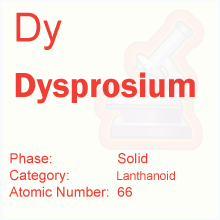 Periodic Table -> Dysprosium
Periodic Table -> DysprosiumDysprosium
Dysprosium DetailsDysprosium Symbol: Dy
Dysprosium Atomic Number: 66
Dysprosium Atomic Weight: 162.50
What is Dysprosium?
Dysprosium (symbol Dy, number 66) is a rare element, which is never found as a free element in nature. It has seven isotopes. Dysprosium was discovered in 1886, but it was not isolated until later, when ion exchange methods started to be used. The element was discovered by the French chemist de Boisbaudran as an impurity in erbium's oxide erbia. It was isolated in 1906 by another French chemist, Georges Urbain. However, it was only in the 1950s when pure samples were produced.
Dysprosium is a component of fergusonite, xenotime, blomstrandine, euxenite, gadolinite, polycrase, and other minerals. Currently, most of the dysprosium deposits are found in mines located in southern China. It is rarely found in the Earth’s crust and in sea water.
Dysprosium is produced mainly by means of processing monazite sand, which is a compound containing a large number of phosphates. The metal is derived as a by-product in the extraction of yttrium. It is isolated by using magnetic processes.
About 100 tons of the metal are obtained worldwide each year. The price of dysprosium has increased by almost 20 between 2003 and 2010. According to informed sources, this metal is among the most important components in newly emerging clean energy technologies. It is believed that we will experience a drastic shortage of dysprosium in 2015 and after that.
Dysprosium may be used to make laser materials jointly with other elements. Such materials are vanadium as well as other earth elements. The element is also used to produce control rods in nuclear reactors and in data storage, because it is highly magnetic. Given that dysprosium has a high melting point and absorbs neutrons easily, it can be used in nuclear reactors when alloyed with steal. Dysprosia or dysprosium oxide is used for cooling nuclear reactor tubes. To this purpose, it is added to a special type of cement after being combined with nickel. Other compounds of dysprosium include dysprosium sulfate, dysprosium iodide, and dysprosium fluoride.

A small part of the composition of neodymium-iron-boron magnets may be replaced by dysprosium in order to enhance the power capacity for applications in drive motors for hybrid-type electricity-driven vehicles. Experts estimate that this will take around 100 grams of the metal for every hybrid car that is manufactured. If you take the figure two million – which is how many cars Toyota makes in a year – it is easy to see even for a layman that we are going to run out of supplies of the metal. Dysprosium is resistant to corrosion, which makes it a very good choice for a wide variety of applications apart from that in vehicles.
The metal is also used in Terfenol-D, a compound with extremely high room-temperature magnetostriction, in dosimeters, catalysts, high intensity lighting, and more. Terfenol-D as a substance is used in transducers, high-precision liquid fuel injectors and broadband mechanical resonators. Two compounds of dysprosium, dysprosium bromide and dysprosium iodide are used to make high-intensity lighting. These compounds release dysprosium ions, which produce bright light by re-emitting.
Dosimeters are used to measure ionizing radiation. This happens by mixing the metal with calcium sulfate or calcium fluoride, types of crystals. When these have been subjected to radiation, dysprosium becomes luminescent, which is used as an indicator to establish to what exposure the dosimeter has been subjected.
You can
link to this page, using the code below:
Periodic Table |
Banks
© ElementsDatabase.com 2015 | Privacy | About | Contact